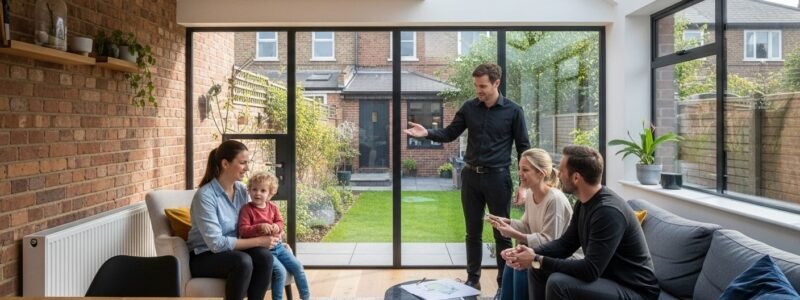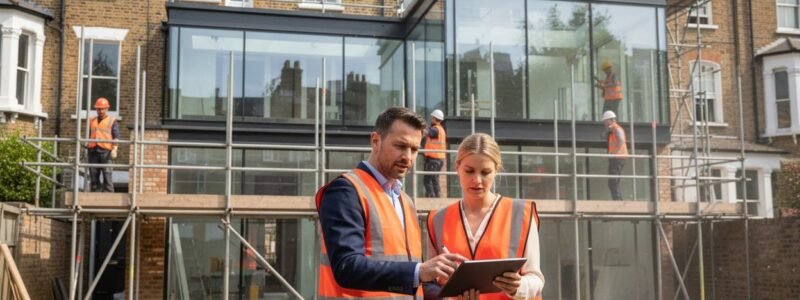Contemporary home extensions are changing the way people live. Some London homeowners have seen their property value climb by up to 20 percent after a well-designed modern extension. Everyone expects bigger spaces and more light, that is no surprise. The real shock is how these extensions are actually redefining the very meaning of home, turning old layouts into flexible, future-proof environments that adapt with your life.
Table of Contents
- Defining Contemporary Extension: A New Era In Home Design
- The Significance Of Contemporary Extensions In Urban Living
- How Contemporary Extensions Enhance Property Value And Functionality
- Key Features And Styles Of Contemporary Extensions
- Real-Life Examples: Successful Contemporary Extensions In London
Quick Summary
| Takeaway | Explanation |
|---|---|
| Contemporary extensions enhance home functionality | These extensions create adaptable living spaces that align with modern lifestyle needs. |
| Sustainability is a key design principle | Thoughtful extensions reduce waste and improve energy efficiency by retrofitting existing structures. |
| Increase property value significantly | Extensions can raise home market value by 10-20%, making them strategic financial investments. |
| Urban challenges are addressed creatively | They maximize residential space and reduce relocation costs in densely populated areas. |
| Integration with existing structures is crucial | Successful extensions harmonize with original designs while introducing modern aesthetics and functionality. |
Defining Contemporary Extension: A New Era in Home Design
Contemporary extension represents a radical reimagining of residential space transformation, moving far beyond traditional home improvement approaches. At its core, this design philosophy merges architectural innovation with functional living requirements, creating spaces that are not merely additions but holistic reimaginings of domestic environments.
The Philosophical Shift in Home Design
Unlike conventional extensions that often appear disconnected or jarring, contemporary extensions integrate seamlessly with existing structures. According to the National Design Guide, well-designed spaces must fundamentally understand and respond to their surrounding context, respecting local architectural heritage while introducing modern design principles.
Key characteristics of contemporary extensions include:
- Fluid spatial connections between old and new architectural elements
- Emphasis on natural light and open plan configurations
- Use of materials that complement yet distinctively contrast with original structures
- Prioritisation of sustainability and energy efficiency
Architectural Principles and Modern Interpretations
Contemporary extensions are not simply about adding square metres but creating intelligent living environments. These designs challenge traditional boundaries, introducing flexible spaces that adapt to changing lifestyle needs. Architects and designers now view extensions as opportunities to completely reimagine domestic spatial relationships.
For homeowners considering such transformations, this approach means moving beyond purely functional considerations. Learn more about seamless modern design strategies that can dramatically enhance your living experience.
The contemporary extension represents more than a structural addition. It embodies a sophisticated design philosophy that recognises homes as dynamic, evolving environments capable of reflecting personal aesthetics, technological advancements, and changing family dynamics.
The Significance of Contemporary Extensions in Urban Living
Contemporary extensions represent more than architectural innovations. They are strategic responses to the complex challenges of urban living, addressing critical spatial constraints while simultaneously enhancing property value and quality of life.
Solving Urban Space Challenges
In densely populated urban environments, land availability is increasingly scarce and expensive. According to new government regulations, homeowners can now add up to two additional storeys through expedited approval processes. This legislative shift acknowledges the critical need for flexible, adaptive living spaces without extensive redevelopment.
Key urban living challenges addressed by contemporary extensions include:
- Maximising limited residential footprints
- Creating multi-functional living environments
- Reducing relocation costs and disruption
- Enhancing property market value
Economic and Environmental Implications
Contemporary extensions are not merely aesthetic upgrades but strategic investments. They offer significant economic advantages by transforming existing structures without requiring complete rebuilds.
Explore extension strategies for urban homes that balance practicality with innovative design.
Moreover, thoughtful extension design contributes to broader environmental sustainability. By retrofitting and expanding existing structures, homeowners reduce construction waste, minimise carbon emissions associated with new builds, and create more energy-efficient living spaces.
The contemporary urban extension embodies a holistic approach to residential design. It represents an intelligent solution that respects architectural heritage, addresses modern lifestyle needs, and provides sustainable, adaptable living environments in increasingly complex urban landscapes.
How Contemporary Extensions Enhance Property Value and Functionality
Contemporary extensions transcend traditional home improvement strategies, emerging as sophisticated investment tools that dramatically transform residential spaces while delivering substantial financial and lifestyle benefits.
Financial Value Proposition
According to the Office for National Statistics, property extensions represent a strategic approach to increasing home market value. Intelligent design can potentially boost property worth by 10-20%, making them far more than mere aesthetic upgrades.
Key financial advantages include:
- Immediate property value appreciation
- Reduced relocation expenses
- Enhanced marketability during future sales
- Lower cost compared to purchasing a larger property
Functional Transformation of Living Spaces
Contemporary extensions are meticulously engineered living solutions that reimagine residential functionality. They create adaptable environments addressing evolving lifestyle requirements without compromising existing architectural integrity. Discover our comprehensive extension design approach that seamlessly integrates new spaces with existing structures.
Beyond monetary considerations, these extensions offer profound lifestyle improvements by:
- Creating multi-purpose living areas
- Introducing natural light and improved spatial flow
- Enabling remote working configurations
- Supporting multigenerational living arrangements
The strategic implementation of contemporary extensions represents a nuanced approach to residential development. By balancing economic prudence with innovative design, homeowners can create dynamic living environments that adapt to changing personal and professional needs while making sound long-term investments.
Key Features and Styles of Contemporary Extensions
Contemporary extensions represent sophisticated architectural interventions that blend innovative design principles with functional living requirements, transforming residential spaces through strategic aesthetic and structural approaches.
Architectural Design Principles
According to the National Model Design Code, contemporary extensions must respect existing architectural contexts while introducing distinctive design elements. This balanced approach ensures that new spaces complement rather than compete with original structures.
The following table summarises the primary architectural features and characteristics of contemporary home extensions as outlined in the article.
| Feature | Description |
|---|---|
| Seamless Integration | New and old spaces blend harmoniously |
| Flexible Spatial Configurations | Spaces adapt to changing needs |
| Emphasis on Natural Light | Maximises daylight through open plans and glazing |
| Innovative Material Selections | Uses modern, sustainable or contrasting materials |
| Visual Connectivity | Enhances interaction between different areas of the home |
| Sustainable/Energy-Efficient Design | Reduces waste, improves efficiency, supports eco principles |
| Respect for Architectural Context | Complements the home’s original design and environment |
Key architectural characteristics include:

- Seamless integration with existing building form
- Innovative material selections
- Flexible spatial configurations
- Emphasis on natural light and visual connectivity
Stylistic Expressions and Material Innovations
Contemporary extensions embrace diverse design languages, ranging from minimalist glass structures to bold geometric volumes. These approaches transform extensions from mere functional additions into statement architectural interventions. Explore our design philosophy for urban extensions that balance aesthetic innovation with practical considerations.
Predominant contemporary extension styles encompass:
- Minimalist glass box extensions
- Organic curved forms
- Industrial raw material aesthetic
- Sustainable eco-friendly designs
The evolution of contemporary extensions reflects broader architectural trends, demonstrating how residential spaces can dynamically adapt to changing lifestyle needs while maintaining aesthetic integrity and functional excellence.
Real-life Examples: Successful Contemporary Extensions in London
London’s architectural landscape demonstrates remarkable innovation through contemporary home extensions, transforming traditional properties into dynamic, functional living spaces that reflect modern lifestyle requirements and design sensibilities.
Urban Transformation Case Studies
According to the Housing Design Case Studies, successful contemporary extensions in London showcase how strategic architectural interventions can dramatically reimagine residential spaces. These projects exemplify intelligent design principles that balance aesthetic innovation with practical functionality.
Key characteristics of successful London extensions include:
- Maximising limited urban property footprints
- Creating multi-functional living environments
- Enhancing natural light and spatial connectivity
- Integrating sustainable design principles
Architectural Innovation and Contextual Design
Contemporary extensions in London represent sophisticated spatial solutions that respect existing architectural contexts while introducing bold, innovative design elements. Discover extension possibilities in West London that demonstrate how thoughtful design can transform residential spaces.
Notable extension approaches observed in London include:
- Glass box extensions creating seamless indoor outdoor connections
- Vertical expansions utilizing permitted development rights
- Minimalist structures with clean geometric lines
- Adaptive reuse of industrial materials
These real-life examples illustrate how contemporary extensions are not merely structural additions but holistic design interventions that respond dynamically to urban living challenges, personal lifestyle needs, and architectural innovation.

Transform Your Home the Contemporary Way with Reltic Extend
Are you struggling to balance modern living needs with limited space and the complexities of urban expansion? The idea of a seamless, functional, and beautifully designed contemporary extension can feel out of reach when faced with confusing planning requirements, tight budgets, and the challenge of blending old with new. By understanding the foundations of contemporary extension, you have already set the stage for a smarter home transformation. Discover more lifestyle and home ideas for modern living to inspire your vision and address your personal goals.

Take the next step today. With Reltic Extend, you gain expert guidance and specialist project management from concept to completion. Our transparent pricing, tailored designs, and deep understanding of London’s property market mean your home can evolve without hassle or compromise. Visit Reltic Extend to explore solutions or find practical design and build tips for your home extension project. Let us help you create a contemporary extension that is truly bespoke and future-ready—request your free consultation now and turn your new era of home living into reality.
Frequently Asked Questions
What is a contemporary extension?
A contemporary extension is a modern approach to expanding residential spaces that emphasizes seamless integration with existing architecture, innovative design, and functional living. It transforms homes into dynamic environments that meet current lifestyle needs.
How do contemporary extensions differ from traditional home extensions?
Contemporary extensions focus on blending modern design principles with existing buildings, creating fluid spatial connections and prioritising natural light, whereas traditional extensions may appear disconnected or less harmonious with the original structure.
Below is a comparison table highlighting the key differences between contemporary and traditional home extensions, as discussed in the article.
| Aspect | Contemporary Extension | Traditional Extension |
|---|---|---|
| Integration with Existing Home | Seamless blending; fluid spatial connections | Often appears disconnected or jarring |
| Design Focus | Modern design; open plan; natural light emphasis | May retain compartmentalised, outdated layouts |
| Materials | Innovative, sustainable, contrasting yet complementary materials | Conventional, often matching original fabric |
| Adaptability | Flexible, future-proof; meets evolving lifestyle needs | Primarily functional, less adaptive |
| Sustainability | Prioritises energy efficiency and minimal environmental impact | Environmental considerations less prominent |
What are the benefits of a contemporary extension for urban living?
Contemporary extensions maximise limited urban spaces, creating multi-functional living environments and potentially increasing property value. They also provide sustainable solutions by enhancing existing structures without extensive redevelopment.
What design principles are commonly applied to contemporary extensions?
Common design principles include respecting the existing architectural context, ensuring a seamless integration of new and old elements, using innovative materials, and creating flexible spatial configurations that enhance natural light and visual connectivity.




